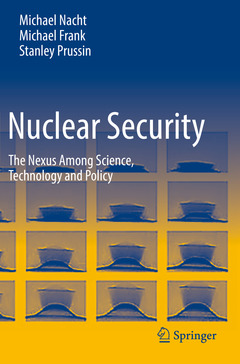Nuclear Security, 1st ed. 2021 The Nexus Among Science, Technology and Policy
Auteurs : Nacht Michael, Frank Michael, Prussin Stanley

Michael Nacht is the Thomas and Alison Schneider Professor of Public Policy at the University of California, Berkeley. He is co-author and co-editor of Strategic Latency and World Power (Lawrence Livermore National Laboratory, 2014), the author of The Age of Vulnerability: Threats to the Nuclear Stalemate (Brookings, 1985) and more than eighty journal articles (in Foreign Affairs, Foreign Policy, Survival, Daedalus and others) and book chapters. He has twice served in US Senate-confirmed positions associated with nuclear weapons policy. He was Assistant Secretary of Defense for Global Strategic Affairs (2009-2010) for which he received the Distinguished Public Service Medal, the Department’s highest civilian honor. Previously he was Assistant Director for Strategic and Eurasian Affairs of the US Arms Control and Disarmament Agency (1994-1997) for which he received the Distinguished Honor Award, the Agency’s highest honor. He received a B.S. in Aeronautics and Astronautics andan M.S. in Operations Research from New York University and a Ph.D. in Political Science from Columbia University.
Michael Frank is a design physicist at the Lawrence Livermore National Laboratory who splits his time between work related to the nuclear weapons stockpile and countering nuclear terrorism. He worked previously for a decade on nuclear threat assessment and incident response. Dr. Frank received a B.S.E. in Aerospace Engineering from Princeton University, an M.P.P. from Harvard's Kennedy School of Government, and a Ph.D. in Nuclear Engineering from the University of California, Berkeley. He and Dr. Nacht have taught the course on which the book is based at the University of California, Berkeley.
Professor Stanley Prussin was a faculty member in the University of California, Berkeley Department of Nuclear Engineering from 1966-2015. For many years he taught the Department's courses in nuclear physics for applications and engineering science applications of nuclear
Date de parution : 11-2022
Ouvrage de 340 p.
15.5x23.5 cm
Date de parution : 11-2021
Ouvrage de 340 p.
15.5x23.5 cm
Thèmes de Nuclear Security :
Mots-clés :
nuclear security textbook; nuclear enrichment; atomic energy commission; arms control measures; nuclear proliferation; nuclear deterrence; nuclear weapons verification; nuclear detonation monitoring; regional proliferation; nuclear disarmament; nuclear stockpile stewardship; nuclear materials detection; nuclear forensics; radiation detection; pre- and post-detonation nuclear forensics; closed fuel cycle policy; proliferation resistant policy; climate change and nuclear war; radiological terrorism; nuclear stockpile surveillance



